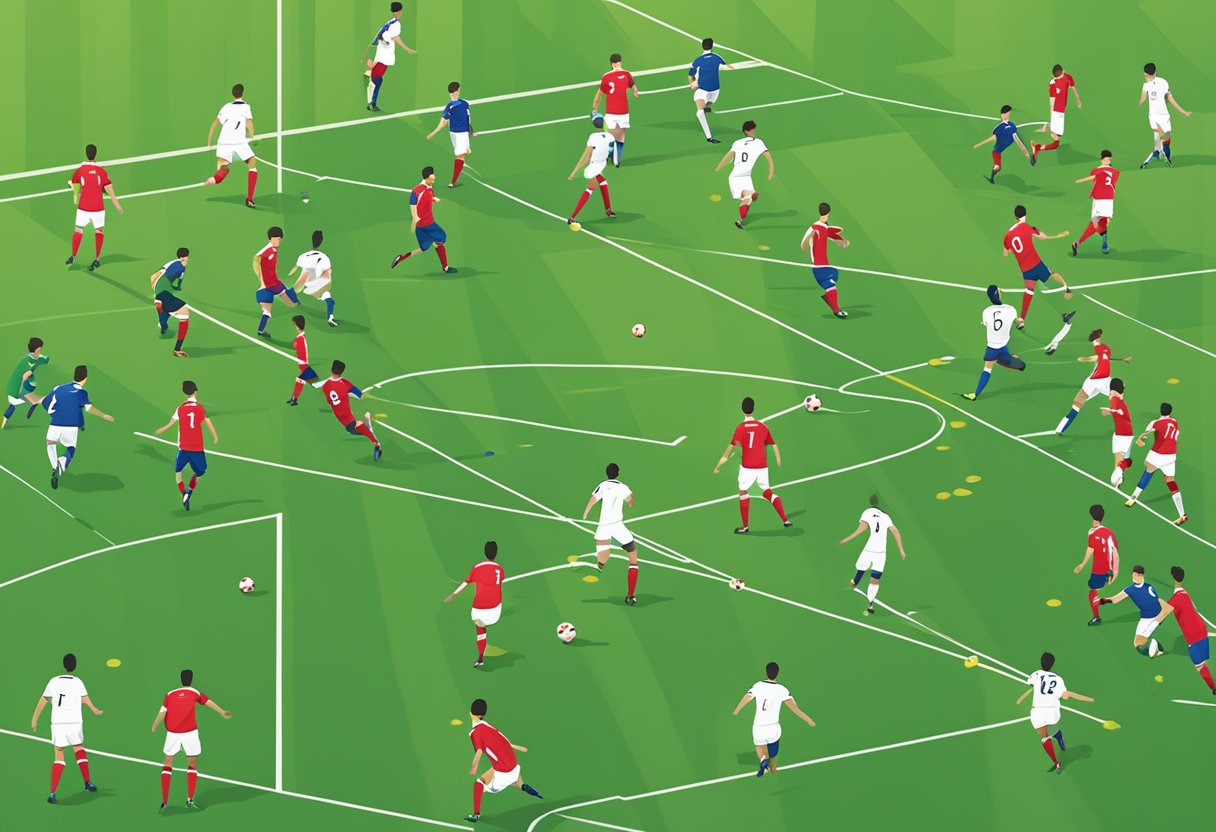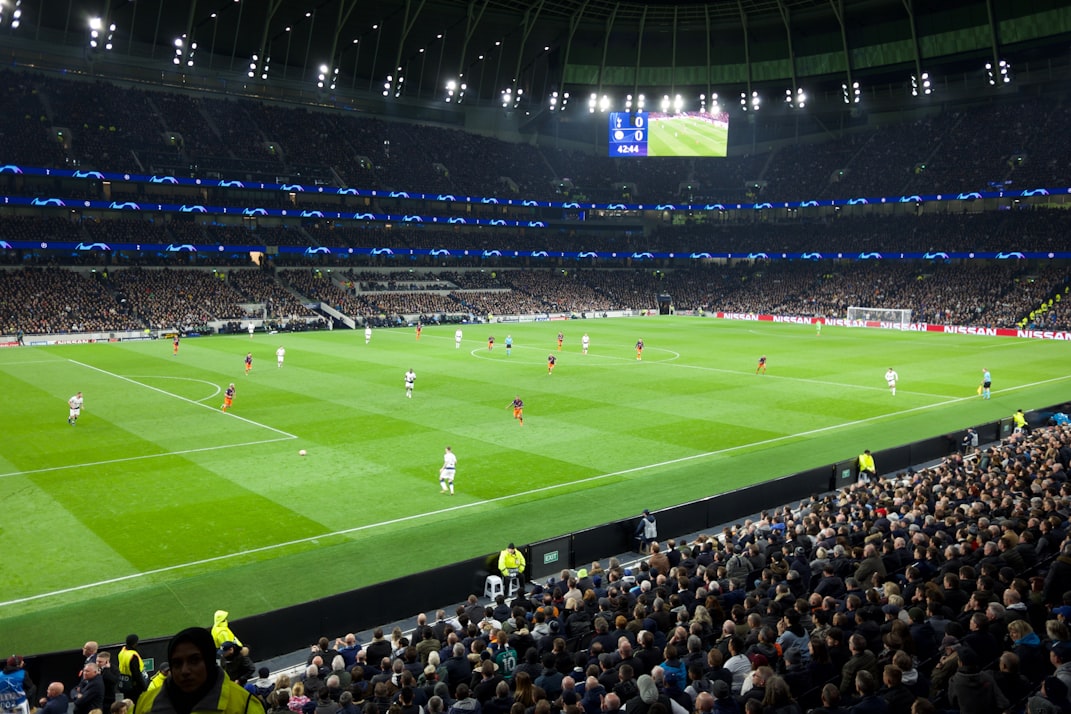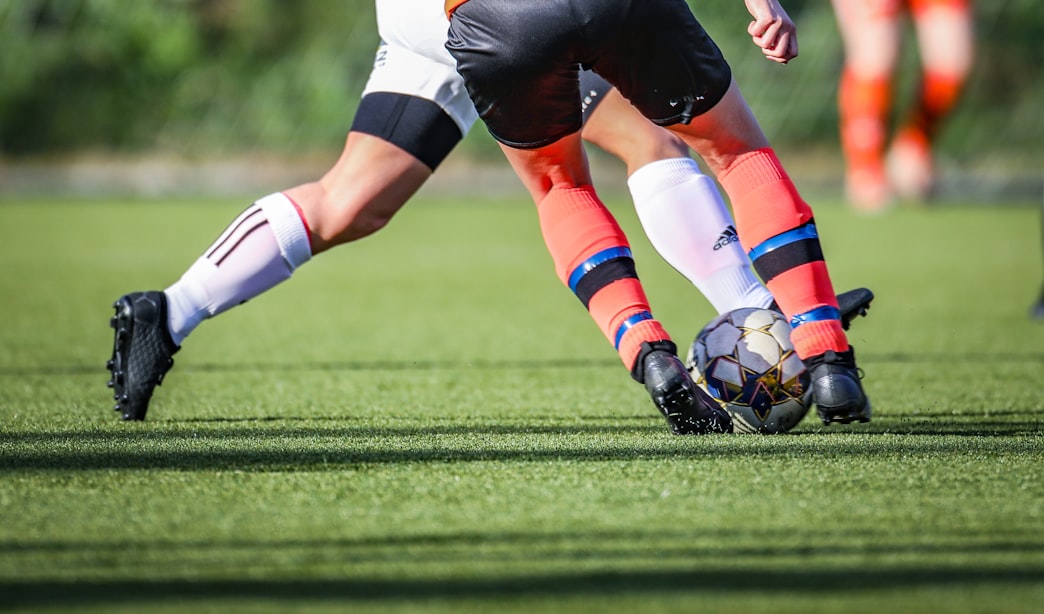Football formations play a crucial role in the success of a team.
A formation is a tactical plan that determines how a team will position its players on the field.
It is a way of organising players into different positions to achieve specific objectives.
The formation chosen by a team can have a significant impact on the outcome of a match.

There are many different football formations that a team can use, each with its own strengths and weaknesses.
Choosing the right formation depends on a number of factors, including the team's style of play, the strengths and weaknesses of the players, and the opposition.
Some formations are more defensive, while others are more attacking.
The 4-4-2 formation, for example, is a popular choice for teams that want to balance defence and attack, while the 4-3-3 formation is often used by teams that want to play an attacking style of football.
History of Football Formations
Football formations have evolved over the years, with coaches and managers always looking for the best way to organise their players on the pitch. In this section, we will explore the history of football formations, from the early developments to modern innovations.
Early Developments
In the early days of football, players would simply line up in a row and charge at the opposing team.
However, as the game became more structured, players began to adopt more defined positions on the pitch.
One of the first formations to emerge was the 1-2-7, which consisted of one goalkeeper, two full-backs, two half-backs, and seven forwards.
This formation was used by many teams in the late 1800s, but it was quickly replaced by more balanced systems.
Evolution in the 20th Century
The 2-3-5 formation, also known as the "pyramid," became popular in the early 1900s.
This formation consisted of two full-backs, three half-backs, and five forwards.
It was a more balanced formation than the 1-2-7 and allowed teams to control the midfield.
However, as defences became stronger, teams began to adopt more defensive formations, such as the 5-3-2.
In the 1950s, the 4-2-4 formation was introduced.
This formation consisted of four defenders, two midfielders, and four forwards.
It was an attacking formation that allowed teams to put more pressure on the opposition's defence.
The 4-2-4 was used by many successful teams in the 1950s and 1960s, but it was eventually replaced by more defensive formations.
Modern Innovations
In recent years, teams have experimented with a variety of formations, including the 4-3-3, 4-4-2, and 3-5-2.
These formations allow teams to adapt to different opponents and playing styles.
For example, the 4-3-3 is an attacking formation that allows teams to control possession and create scoring opportunities, while the 3-5-2 is a more defensive formation that is effective against teams with strong attacking players.
Overall, football formations have come a long way since the early days of the sport. Coaches and managers continue to experiment with new formations and tactics, and it will be interesting to see what the future holds for football formations.
Basic Principles of Football Formations
Football formations are the systematic arrangement of players on the field to achieve a specific tactical objective.
A team's formation can vary based on the opposition, the players available, and the game situation. However, there are some basic principles of football formations that remain constant.
Common Football Formations
Football formations are the way coaches organise their players on the field. They can vary depending on the team's strengths, weaknesses, and playing style.
Here are some of the most common football formations used today.
4-4-2
The 4-4-2 formation is one of the oldest formations still in use today. It consists of four defenders, four midfielders, and two forwards. The midfielders are split into two central midfielders and two wide midfielders. This formation is versatile and can be used for both attacking and defensive play.
4-3-3
The 4-3-3 formation is an attacking formation that consists of four defenders, three midfielders, and three forwards. The midfielders are split into one central midfielder and two wide midfielders. This formation is popular with teams that have strong attacking players and want to dominate possession.
3-5-2
The 3-5-2 formation is a flexible formation that can be used for both attacking and defensive play. It consists of three defenders, five midfielders, and two forwards. The midfielders are split into three central midfielders and two wide midfielders. This formation allows for a lot of movement and can be used to overload the midfield.
5-3-2
The 5-3-2 formation is a defensive formation that consists of five defenders, three midfielders, and two forwards. The midfielders are split into one central midfielder and two wide midfielders. This formation is often used by teams that want to defend deep and hit on the counter-attack.
Overall, football formations can vary depending on the team's strengths, weaknesses, and playing style. Coaches must choose the right formation to get the most out of their players.
Positional Roles and Responsibilities
In football, each player has a specific role and responsibility depending on their position. The team's success depends on how well each player carries out their duties. Here are the four main positions in football and their respective roles and responsibilities.
Goalkeeper
The goalkeeper is the last line of defence and the only player allowed to use their hands within the penalty area. Their primary role is to prevent the opposing team from scoring by stopping shots on goal. In addition, they must also be able to communicate effectively with their defenders to organise the team's defence and anticipate potential threats.
Defenders
Defenders are responsible for protecting the team's goal and preventing the opposition from scoring. They are usually positioned in front of the goalkeeper and work together to form a solid defensive line. Their main responsibilities include marking opposing players, intercepting passes, and making tackles. Defenders must also be able to clear the ball out of danger and start counter-attacks by passing the ball to their midfielders.
Midfielders
Midfielders are the link between the defence and the forwards. They are responsible for controlling the midfield and distributing the ball to their teammates. Their roles and responsibilities vary depending on their position within the midfield. For example, defensive midfielders are responsible for breaking up the opposition's attacks and protecting their own defence, while attacking midfielders are responsible for creating scoring opportunities for their forwards.
Forwards
Forwards are responsible for scoring goals and creating scoring opportunities for their teammates. They are usually positioned closest to the opposition's goal and must be able to finish with accuracy and power. Forwards must also be able to create space for themselves and their teammates by making runs and dribbling past defenders.
In summary, each player's position in football comes with specific roles and responsibilities. The goalkeeper must prevent the opposing team from scoring, defenders must protect their own goal, midfielders must control the midfield, and forwards must score goals. By working together and carrying out their duties effectively, the team can achieve success on the pitch.
Adapting Formations in Play
Football formations are not set in stone. Coaches must be able to adapt their formations to suit different situations and opponents. In this section, we will explore two key aspects of adapting formations: switching formations and counteracting opponents.
Switching Formations
Switching formations during a match can give a team a strategic advantage over their opponents. For example, if a team is struggling to break down their opponent's defence, they may switch to a more attacking formation such as a 3-4-3 or a 4-3-3. On the other hand, if a team is leading and wants to protect their lead, they may switch to a more defensive formation such as a 5-4-1 or a 4-5-1.
It is important to note that switching formations during a match requires careful planning and execution. Coaches must ensure that their players understand their new roles and responsibilities, and that they have had sufficient practice playing in the new formation.
Counteracting Opponents
Another key aspect of adapting formations is counteracting opponents. Different opponents will have different strengths and weaknesses, and coaches must be able to adapt their formations to exploit their opponents' weaknesses and neutralise their strengths.
For example, if an opponent is playing with two strikers, a coach may choose to play with three central defenders to provide extra cover at the back. Alternatively, if an opponent is playing with a single striker, a coach may choose to play with only two central defenders and an extra midfielder to dominate the midfield.
In summary, adapting formations in play is an essential aspect of modern football. Coaches must be able to switch formations and counteract opponents to make the most of their players' strengths and exploit their opponents' weaknesses.
Influence of Formations on Match Outcomes
Football formations have a significant influence on match outcomes. Coaches select formations based on their team's strengths and weaknesses, as well as the opponent's style of play. A team's formation affects the distribution of players on the pitch, which in turn affects their ability to defend and attack. In this section, we will explore the influence of formations on match outcomes.
Statistical Analysis
Statistical analysis has shown that certain formations are more effective than others. According to a systematic review by Forcher et al. (2023), the 4-4-2 and 4-2-3-1 formations are the most commonly used in professional football. The study found that the 4-4-2 formation was effective in controlling the midfield and creating scoring opportunities, while the 4-2-3-1 formation was effective in maintaining possession and creating chances through the wings.
Another study by PLOS ONE (2019) examined the impact of different formations on tactical key performance indicators (KPIs) using positional data in a controlled experiment. The study found that the 4-2-3-1 formation was more effective in creating scoring opportunities, while the 3-5-2 formation was more effective in controlling the midfield.
Case Studies
Case studies have also shown the influence of formations on match outcomes. In the 2009 UEFA Champions League Final, Barcelona defeated Manchester United 2-0 using their signature 4-3-3 formation. Barcelona controlled the midfield and created numerous scoring opportunities, while Manchester United struggled to maintain possession and create chances.
In the 2018 FIFA World Cup Final, France defeated Croatia 4-2 using a 4-2-3-1 formation. France's formation allowed them to control the midfield and create scoring opportunities through the wings. Croatia's 4-3-3 formation was unable to match France's midfield dominance, resulting in a loss.
In conclusion, football formations have a significant influence on match outcomes. Statistical analysis and case studies have shown that certain formations are more effective than others. Coaches must carefully select formations based on their team's strengths and weaknesses, as well as the opponent's style of play.
Training and Drills for Formation Mastery
To master any football formation, players and teams need to undergo rigorous training and drills. Below are some defensive, midfield, and attacking drills that can help players and teams perfect their formation.
Defensive Drills
Defensive drills are essential for any team that wants to maintain a solid defence while playing in any formation. Some of the drills that can help players improve their defensive skills include:
- One on One Defending: This drill involves two players, one attacker and one defender. The defender's goal is to prevent the attacker from scoring by staying in front of them, blocking their shots, and tackling them when necessary.
- Zonal Defending: This drill involves players defending a specific area of the pitch. Players are taught to work together to prevent attackers from entering their zone and to close down space quickly to prevent shots on goal.
- Recovery Runs: This drill involves defenders running back to their positions after an attack. Players are taught to recover quickly and to communicate with their teammates to ensure that everyone is in the right position.
Midfield Exercises
The midfield is the engine room of any team, and mastering midfield play is essential for any team looking to dominate the game. Some of the drills that can help players improve their midfield skills include:
- Passing and Receiving: This drill involves players passing the ball to each other while on the move. The focus is on accuracy, speed, and timing, with players encouraged to take no more than two touches.
- Transition Play: This drill involves players quickly transitioning from defence to attack. Players are taught to move the ball quickly and to find space while maintaining possession.
- Pressing: This drill involves players pressing the opposition when they have the ball. Players are taught to work together to close down space and to force the opposition into making mistakes.
Attacking Drills
Attacking drills are essential for any team looking to score goals and win games. Some of the drills that can help players improve their attacking skills include:
- Finishing: This drill involves players taking shots on goal from different angles and positions. Players are taught to shoot accurately and to make good decisions when in front of the goal.
- Crossing and Heading: This drill involves players crossing the ball into the box, and other players attempting to head the ball into the net. Players are taught to time their runs and jumps correctly and to head the ball with accuracy.
- Overlapping Runs: This drill involves players making overlapping runs to create space and open up the opposition's defence. Players are taught to time their runs correctly and to communicate with their teammates to ensure that everyone is on the same page.
By incorporating these drills into their training sessions, players and teams can improve their skills and master any formation they choose to play.
Frequently Asked Questions
How are football formations categorised and what do the numbers represent?
Football formations are categorised by the number of players in each position. The first number represents the number of defenders, the second number represents the number of midfielders, and the third number represents the number of forwards. For example, the 4-4-2 formation has four defenders, four midfielders, and two forwards.
What are the strategic advantages of using a 4-3-3 formation in football?
The 4-3-3 formation is an attacking formation that allows for quick transitions from defence to attack. The three forwards provide a strong attacking presence, while the three midfielders provide support and cover for the defence. This formation is also flexible, allowing for adjustments in midfield and attack depending on the opposition.
In what ways does the 3-5-2 formation affect team dynamics and defence strategy?
The 3-5-2 formation is a versatile formation that allows for a balance between defence and attack. The three centre-backs provide a solid defensive base, while the wing-backs provide width and support in attack. The five midfielders provide a strong presence in midfield, allowing for quick transitions from defence to attack.
Which football formation is considered the most defensively solid?
The 5-4-1 formation is considered the most defensively solid formation. This formation features five defenders, four midfielders, and one forward. The five defenders provide a strong defensive base, while the four midfielders provide support and cover for the defence. The lone forward is responsible for holding up the ball and providing an outlet for counter-attacks.
How do American football formations differ from those in association football?
American football formations are different from association football formations in that they are designed for a different type of game. American football formations are designed for a game that is more stop-and-start, with a focus on short, explosive plays. Association football formations are designed for a game that is more continuous, with a focus on possession and movement.
What factors should a team consider when choosing their offensive football formation?
When choosing an offensive football formation, a team should consider their strengths and weaknesses, the strengths and weaknesses of the opposition, and the style of play they want to implement. A team should also consider the individual strengths and weaknesses of their players, and how these can be used to best effect within the chosen formation.


















